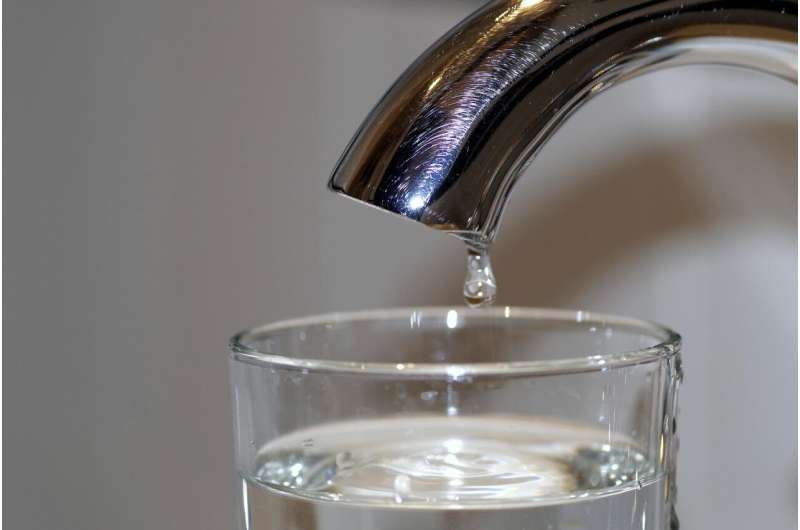This article has been reviewed according to Science X's editorial process and policies. Editors have highlighted the following attributes while ensuring the content's credibility:
fact-checked
reputable news agency
proofread
Toxic secret: Lawmakers want rules and remedies for chemical in Florida County tap water

Two local lawmakers are announcing a bipartisan effort today to regulate a toxic industrial chemical that has tainted the drinking water of thousands of people in Seminole County for years and possibly decades.
There are no mandatory limits or other drinking water regulations for the chemical, 1,4-dioxane, whose dangers were little discussed until a series of reports in the Orlando Sentinel last year. Local authorities say the absence of regulations has left them floundering with little assistance for solutions, unsure of the need for transparency to the public and potentially saddled with huge costs.
State Sen. Linda Stewart, a veteran Democrat from Orlando, will try to remedy that with a bill to be publicly announced Monday in advance of Tuesday's start of the 2024 Florida legislative session.
According to Stewart's office, the bill will be paired with similar legislation to be filed by Rep. Rachel Saunders Plakon of Lake Mary, a Republican first elected to her seat in 2022.
With a wide range of proposed steps, the bill chiefly would require the state "Department of Environmental Protection to adopt and implement rules for a statewide maximum contaminant level for 1,4-dioxane."
1,4-dioxane is a synthetic compound used in manufacturing and occurring incidentally in goods ranging from electronics to cosmetics. The U.S. Environmental Protection Agency lists the chemical as likely to cause cancer.
The bipartisan legislation proposes regular testing for 1,4-dioxane in water pumped up from the Floridan Aquifer, the primary water source for Central Florida, and would impose an allowable limit for the chemical in drinking water.
The allowable limit would be tiny: only 0.35 parts of the chemical per billion parts of water. That concentration has long been Florida's and the EPA's recommended maximum limit for 1,4-dioxane in drinking water, and one that Seminole County authorities have repeatedly cited as their target.
But the state and federal guideline is unenforceable as written and utilities are now under no obligation to test for 1,4-dioxane or report to the public when the chemical is found in drinking water.
"It remains an unregulated contaminant," Seminole County notes on its website. "Drinking contaminated water is the most common way people encounter 1,4-dioxane."
Lake Mary, Sanford and Seminole County detected 1,4-dioxane in their water supply nearly a decade ago after the EPA ordered utilities nationwide to undertake one-time, research testing for that chemical and several others regarded as toxic contaminants of emerging concern.
By then, state and local officials had long been aware of troubles at a shuttered factory in west Lake Mary that had produced telecommunications electronics. It had used 1,4-dioxane decades previously and the chemical was documented in 2001 amid hazardous pollution penetrating into the ground and groundwater at the factory's campus.
Environmental scientists also were learning in the early 2000s that 1,4-dioxane blends readily with water and travels swiftly through aquifers like the Floridan Aquifer.
The three local governments reported their discoveries then of 1,4-dioxane—citywide for Lake Mary and Sanford and in the portion of the county west of Interstate 4—in brief and obscure statements in their annual water quality reports.
There was no further public notification in Seminole County of 1,4-dioxane until last summer when the Orlando Sentinel published a series of reports entitled "Toxic Secret" that recounted the little-known history of the chemical's presence in local water supplies, the potential danger it posed and how scant progress has been made toward a lasting remedy.
Still today, state authorities have not identified who was responsible for the 1,4-dioxane in the Floridan Aquifer where the two cities and county obtain drinking water.
While having no way of knowing the historic extent of public exposure to the chemical in drinking water, Lake Mary, Sanford and Seminole County were able to upgrade or adjust their water systems to keep concentrations of 1,4-dioxane lower than 0.35 parts per billion.
But there is currently no legal requirement that the jurisdictions maintain those reduced concentrations of 1,4-dioxane or publicly report any changes in concentrations.
Stewart's bill, which Plakon's bill is expected to mirror, calls for setting the limit of 0.35 parts per billion, upgrades of water treatment systems to remove 1,4-dioxane and financial help from the state of Florida to remedy contamination.
Findings of 1,4-dioxane in utility testing of tap water will be made "publicly available," the bill states.
2024 Orlando Sentinel.
Distributed by Tribune Content Agency, LLC.



















